The following article is from a talk given by Daniel Ghinn at Mobile Pharma World Europe in Amsterdam, April 25, 2012.
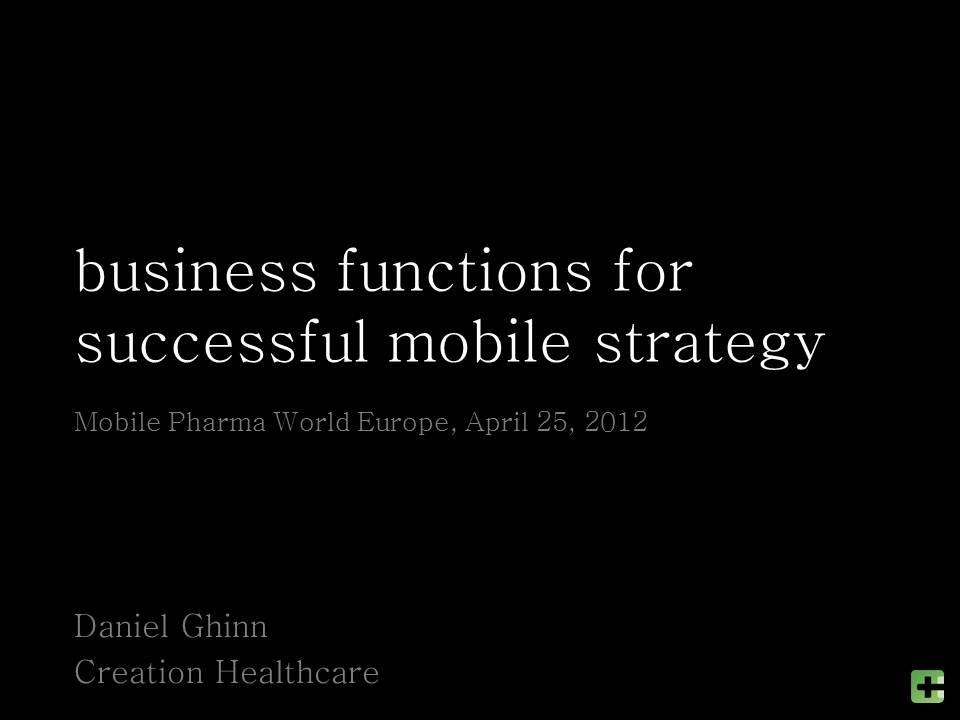
We don’t know what the future holds
I’ve now been working in the area of digital and emerging channels for healthcare for over fifteen years, since I co-founded the company we now call Creation Healthcare, in the 1990’s. And one thing I’m certain of is that we cannot predict the future. We simply do not know what the future holds. Since I run a company that specialises in helping marketers to plan, coming to terms with not knowing what the future holds is important.
Let me illustrate what I mean using a mobile technology example. In the late 1990’s I was at an event organized by the Design Council in London, with various experts talking about business and technology. Tony Wilson, founder of Factory Records and the Hacienda and the man behind British band Joy Division, was there interviewing a panel of experts about design and technology. On that panel was a Director from IBM. The conversation got onto the subject of the role of mobile technology, and this particular industry expert, a director in a major technology and consulting firm, said that there’s no future in SMS texting because “it’s only used by kids”.
So we don’t know what the future holds – we don’t know what technologies will become popular or useful; or what events will take place that will shape public perception about mobile and health. But what we can do – in fact all we can do – is to start with now: what do we know so far; where do we want to get to; and what opportunities are around us that will help us to get there?
To succeed in the context of mobile in pharma, then, we need to understand how to make the most of the opportunities that mobile channels offer us today and in the future, and how to work effectively with those people who are around us, to get us where we want to be – to achieve the outcomes and results we want.
I’m sometimes asked by people in pharmaceutical companies whether I think their company should have a dedicated digital or mobile team. After years of studying this, I have come to a clear conclusion: it depends.
Just like the issue of how to put together the perfect team to make your mobile project a success – it also depends.
So let’s take a look at how you can get this right for your project, in your organization. We’ll look at what makes a good team – which roles among your colleagues will likely help you make it a success; and how to get their support; how to pre-empt any blockers, those potential barriers and instead create what we call ‘pathways’ to successful engagement.
People > technology
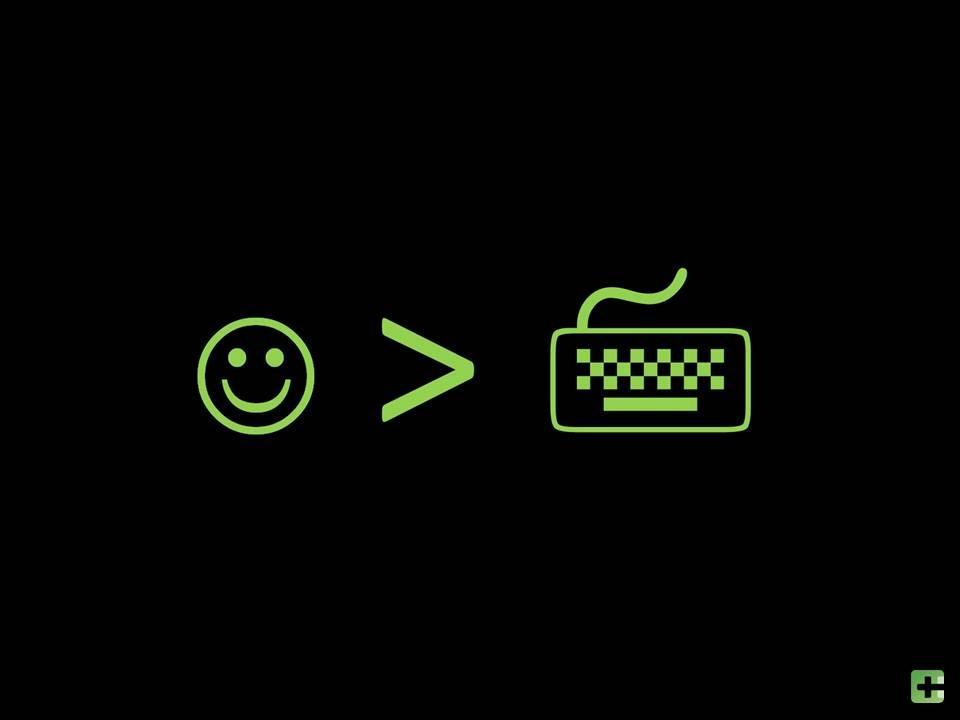
We have a saying at Creation Healthcare that people are greater than technology (people > technology). In other words, if the solution you’re creating is not serving a need people have, the technology is irrelevant. More importantly, it could be a waste of money and time and could lead to a negative perception within your organization of the value that new technologies can bring.

In this sense, a company like Apple is not so much a company that understands technology, it’s a company that understands people. Technology allows them to create great devices that people love to use. Technology is the enabler.
The most intimate technology channel ever?
This idea that ‘people > technology’ is more important than ever before when it comes to mobile, because mobile is a technology platform that is so personal, so intimate. It goes everywhere with us. It knows where we are. That means it’s a platform that can connect with us in context, in a highly relevant way.

In fact, we have allowed mobile technology to invade our lives like no other technology before it. Our mobile devices can wake us in the middle of the night; they can interrupt us in a meeting during the day. They’re with us everywhere.
A survey of almost 2,000 people in Britain last year revealed that around 15% of them have accidentally dropped their mobile down the toilet bowl.
Defining new social rules
Mobile devices have invaded our lives to such an extent that as societies we’ve had to define social rules about how we let our mobile devices interfere with our lives. We’re still often reminded at the start of a meeting to switch our mobiles to silent or even off. I find it fascinating to be in Tokyo and see the cultural rules around mobile phone etiquette. Japan is one of the most advanced countries in the world as far as the use of mobile devices, yet it is considered very bad manners to speak out loud on your phone in public, especially on public transport.

“Let’s build an app!”
This idea that ‘people > technology’ is an idea we would all agree with, of course. In pharma, we use technology to solve real problems that people and the business have.
Yet sometimes, perhaps because we know that channels like mobile have so much untapped potential for our industry and we don’t want to be left behind, we see situations where the technology platform seems to be the driver. “We need to do mobile”. “We need an app”. Have you ever heard that? Have you ever said it?

Be very careful not to get caught in the ‘me too’ hype trap.
Personally, I’m content with the idea that sometimes we need to push the boundary into new channels, to experiment to some extent in our regulated, controlled environment, to discover what’s out there; to explore the possibilities. If we’re up front and honest about this, then projects that are run as experiments can be just that. Measure everything; see what you learn. It helps us to plan better initiatives in the future.
So then, after we’ve experimented and learned, we can use what we’ve learned to plan great mobile tools that we are confident will meet real business needs and solve real problems for real people.
Learning from great practice in healthcare engagement
At Creation Healthcare, as part of our research into great practice in healthcare engagement, each year we run a study into the most effective initiatives that are achieving real outcomes. We call this the Healthcare Engagement Strategy Awards and we receive nominations from all around the world, and we go out and find new initiatives too. Our global team analyse and review each initiative and we develop a shortlist, interviewing the people behind the shortlisted initiatives to discover what’s really going on behind the scenes. We cover all channels but we’re currently seeing some of the most exciting innovation among new and emerging digital channels.
The winning initiatives this year, announced in February, included pharmaceutical companies, healthcare providers, public health initiatives, ranging from the USA to Asia, Europe, Africa.

One of the things we were especially interested in this year was to identify common barriers that had been overcome by these initiatives, and the ‘pathways’ that were created to overcome them. And we found that even though the initiatives were diverse, covering a wide range of social and economic environments; all sorts of channels; addressing different kinds of healthcare challenges, there was a common set of pathways we were able to identify.
We’re not going to go into the full detail of these pathways now – that’s another story – but here are the top five, in order. Here’s how the most successful pioneers among healthcare companies and organizations implement new channels:
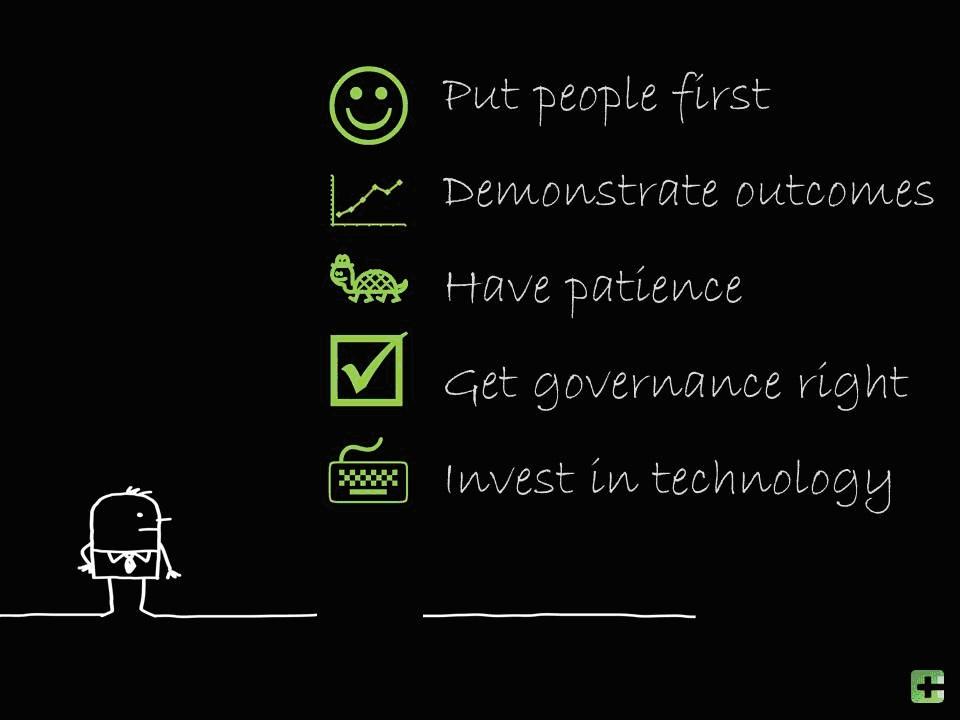
- Put people first
- Demonstrate outcomes
- Have patience
- Get governance right
- Invest in technology
We recently published a survey among people in the pharma industry to ask them about their experiences working in teams to deliver successful mobile initiatives. We asked them how channels like mobile have changed the way they work with their colleagues in other departments. Here are some of their comments:
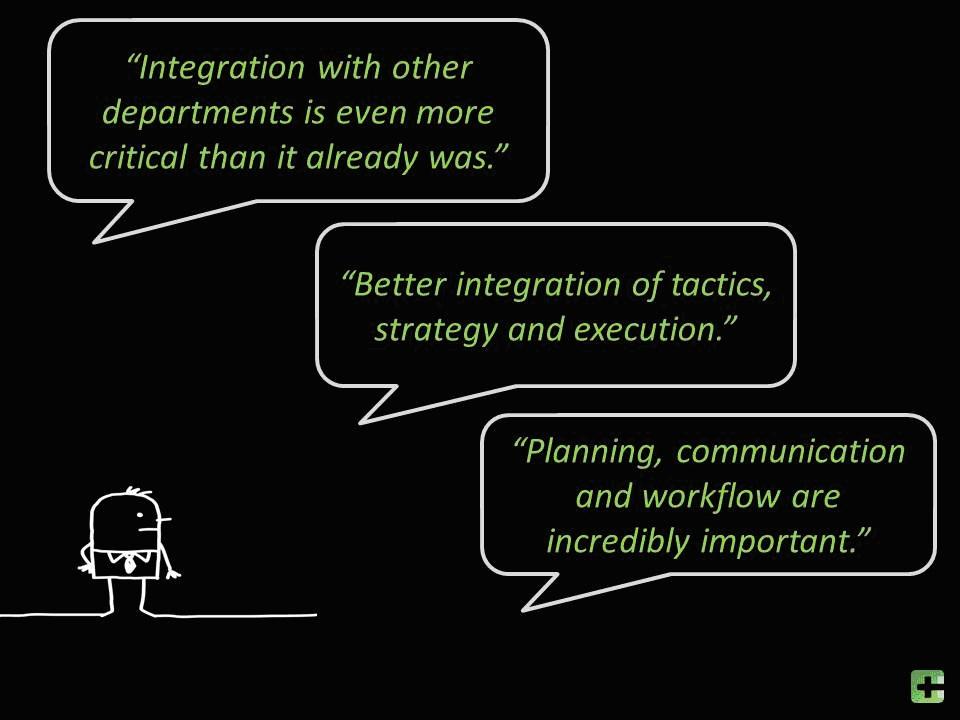
“Integration with other departments is even more critical than it already was.”“Better integration of tactics, strategy and execution.”“Planning, communication and workflow are incredibly important.”
There was a clear sense that better collaboration is necessary, and is taking place, in order to implement new channels effectively. Is this your experience too? Do you find that you have to collaborate more effectively with colleagues from other departments to make things work?
To make this work well, you need to plan to collaborate deliberately. The first step is to recognise that if we’re going to get on those five pathways described above by the most effective pioneers of healthcare engagement, we’ll need to include people from different teams around our organization – and maybe outside of it too – in our plan.
Looking again at those pathways – People. Outcomes. Patience. Governance. Technology – straight away you can probably identify departments who have an interest in some of these. Medical, Regulatory Affairs, and Legal, might be especially interested in Governance; Communications might be too. IT and Digital might have a special interest in Technology. Marketing might be thinking about Outcomes.
Ultimately, it all comes down to planning. Get the planning right and you’ll know whose buy-in you need to make your initiative a success. You must make the case for why this initiative is happening, so that the colleagues who will either create a pathway or a barrier understand the plan and are envisioned by it.
I recently wrote a series about how to do campaign planning in a digital world, and this applies to mobile too. I outlined three things you need to do in planning digital or mobile initiatives:

1. Set goals
What do you want people to do, that you can align with the achievement of business objectives? How will this look in terms of mobile engagement?
Be aware that you won’t necessarily have the same vision of success as your colleagues. So you first need to know what outcomes from your mobile initiative will align with business objectives, and how you will measure these, and then you also need to know what goals your colleagues in other departments have – what does success look like for them? Do you have colleagues, for example, for whom success is defined simply by the fact that nobody gets sued? I’m being ironic of course, but it is important to identify goals from different perspectives.

2. Know your customer
What channels are your customers using, and how? How will the initiative you’re planning fit into their world? How will it make their life better? What is missing from their life that your mobile initiative will deliver? Again we’re talking here about putting people first.
Now a quick word about developing insights. There’s a lot of data out there. You can measure everything – and there’s a lot that you should measure. There’s a real potential for information overload, if you’re not sure what’s useful, what you can learn from what’s useful, and how you can use that to develop a great plan or campaign. If you feel like that, ask somebody who’s independent to help you make sense of it [as an aside, Creation Healthcare can play a very useful role as an independent advisor in translating data into meaningful insights to help you plan – contact my colleague Robert Hanvik if you’d like to know more about this service].
3. Select the right channels
Even if you’ve decided on mobile, what kinds of devices will you include; how will the initiative be deployed; what platforms; will you be looking to integrate social engagement? How will the channels you deploy work together to build a cohesive experience?
You need to be clear on what the possibilities are and to understand the potential merits and risks associated with each option.
You also need to know – and here we connect back with the goals you set – what actions do you want people to take using these channels? What do we want them to learn? What does conversion look like? Fancy metrics mean nothing if you haven’t created something that results in action or change.
A tool for colleague collaboration
So you have a great plan. You know what success looks like. You know which channels and platforms you want to use and how you’ll measure success.
By now you’ll hopefully have engaged at least some of your colleagues from other departments. The key is to be proactive about this part.
The specific colleagues you need to connect with will depend on your organization structure, the way roles and responsibilities are distributed, and of course on where you fit within these roles. So you need to look around you and make sure you know who to get involved. Go wide, proactively, rather than missing out somebody who could put up a barrier later on.
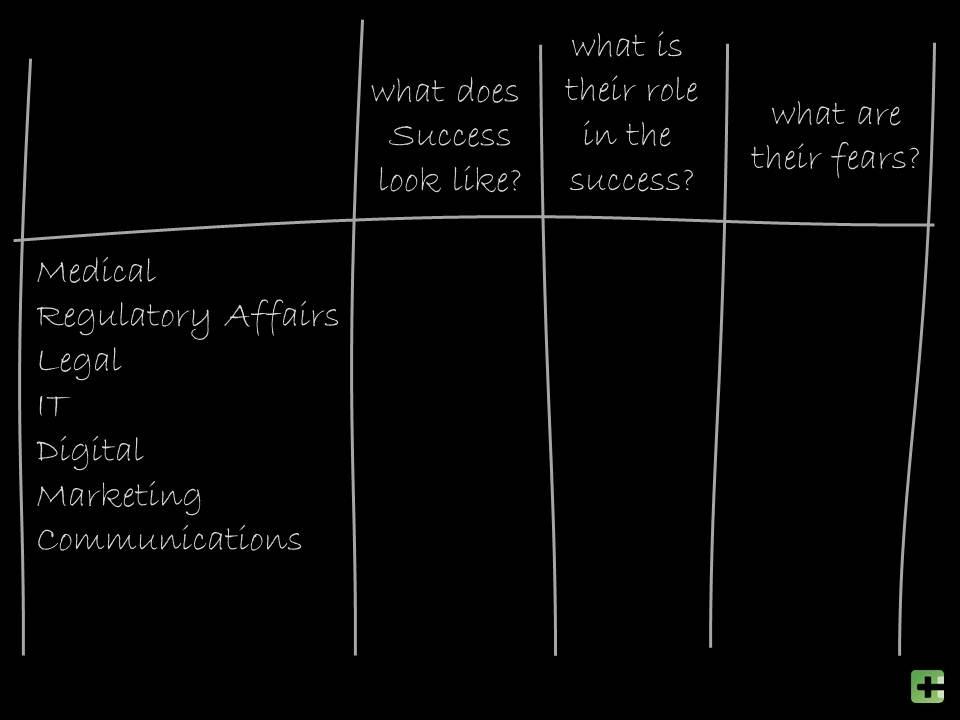
Draw up a list. Let’s say for example, medical / regulatory affairs; legal; IT; Digital; Marketing; Communications.
A quick word about ‘digital’ roles: while we have seen many new roles emerging in pharma teams that are dedicated to digital or ‘e’, it is also interesting to note that these roles are not all implemented in the same way. So we see digital roles ranging from ‘Digital Communications’ to ‘eMarketing’ to other ‘New Technologies’ roles; and we also see roles like ‘MultiChannel Marketing’ which has more of an emphasis on the integration of channels.
We see these roles as roles for this current season – as businesses learn about the role of digital throughout their organization, there may be less need for subject matter experts to operate in this way.
Firstly, make sure that everybody understands the plan and that they have a vision of success for the initiative. Make sure you know what their vision of success is.
For each of these, what is their role in the success of the initiative? Make sure that both you and they have a clear picture of their role.
Now, what are their fears or concerns? Why might this initiative be something they’re not as enthusiastic as you about? There may be plenty of legitimate reasons.
Some of the typical fears we come across include: Capacity – can we handle this? Will it create more work for me? What if it’s a waste of money? I don’t understand it. What about adverse events? Fears about engaging consumers. What if we get reported for breaching the code of practice, and I’m the one who gave it the green light?
The key is this: it’s much easier to identify and address fears early on, when you have space to adapt and when your colleagues don’t feel they’re in a corner.
We’re all learning with every new idea or initiative, so give your colleagues a chance to learn too.
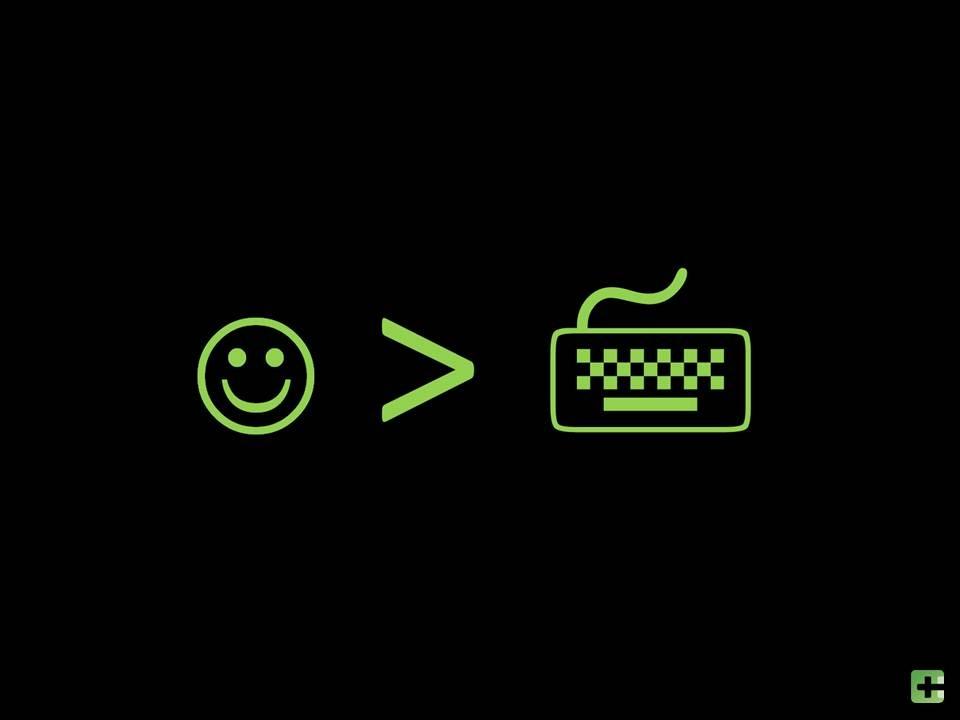
And finally remember, if nothing else, keep just one thing in mind: people > technology.
Get started now
This article is from a talk I have just given at Mobile Pharma World Europe 2012. If any of the issues I have raised have encouraged you to think about how you plan digital or mobile marketing initiatives, I would be very pleased to help you put these principles into practice in your own role.
Get in touch now if you would like a confidential conversation about digital or mobile planning or if you would like me to send you some additional resources to support you.


